ICU护理记录单模板
- 格式:docx
- 大小:16.76 KB
- 文档页数:1
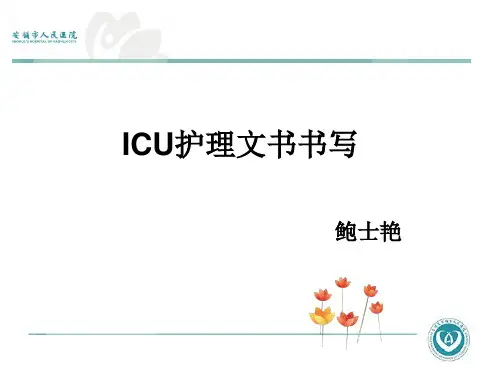

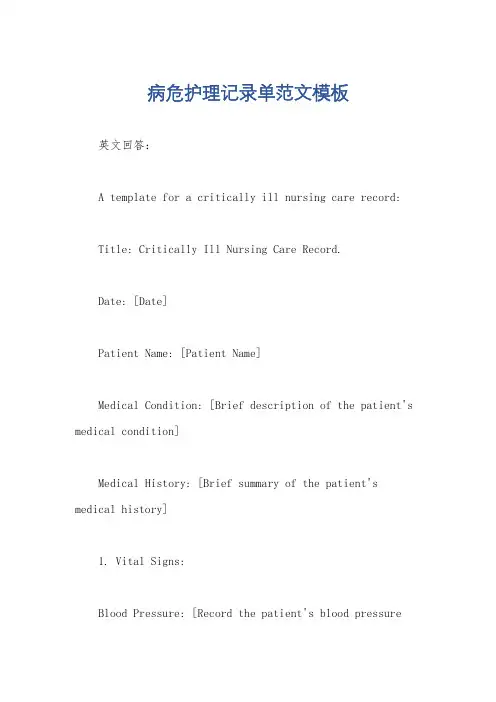
病危护理记录单范文模板英文回答:A template for a critically ill nursing care record:Title: Critically Ill Nursing Care Record.Date: [Date]Patient Name: [Patient Name]Medical Condition: [Brief description of the patient's medical condition]Medical History: [Brief summary of the patient's medical history]1. Vital Signs:Blood Pressure: [Record the patient's blood pressurereadings]Heart Rate: [Record the patient's heart rate readings]Respiratory Rate: [Record the patient's respiratory rate readings]Temperature: [Record the patient's body temperature readings]2. Medications:Name of Medication: [Record the name of the medication] Dosage: [Record the dosage of the medication]Administration Route: [Record the route of administration]Time and Frequency: [Record the time and frequency of medication administration]3. Interventions:Oxygen Therapy: [Record the type and flow rate of oxygen therapy]Intravenous Therapy: [Record the type and rate of intravenous fluids]Wound Care: [Record the type of wound care performed]Pain Management: [Record the pain assessment and interventions]4. Nursing Assessments:Neurological Assessment: [Record the patient's level of consciousness, pupil size, and response to stimuli]Respiratory Assessment: [Record the patient's lung sounds, oxygen saturation, and respiratory effort]Cardiovascular Assessment: [Record the patient's heartsounds, peripheral pulses, and edema]Gastrointestinal Assessment: [Record the patient's bowel sounds, appetite, and bowel movements]5. Communication:Communication with the Patient: [Record any conversations or interactions with the patient]Communication with the Family: [Record any conversations or interactions with the patient's family]6. Other Observations:Skin Integrity: [Record any changes in the patient's skin condition]Urinary Output: [Record the patient's urine output]Laboratory Results: [Record any abnormal laboratory results]7. Plan of Care:Nursing Diagnosis: [Record the nursing diagnosis]Goals: [Record the goals for the patient's care]Interventions: [Record the nursing interventions to achieve the goals]Evaluation: [Record the evaluation of the patient's response to the interventions]中文回答:病危护理记录单范文模板:标题,病危护理记录单。

附件4X X X 医院手术护理及物品清点记录单日期:年月日手术护理记录(器械物品清点)单填写要求手术护理记录单填写说明一、书写原则:1、记录书写内容必须真实准确,包括病人姓名、性别、科室、床号、住院号、年龄、术前诊断、术前皮肤情况、手术开始时间、手术名称、出手术室时间。
2、手术护理记录单一律用蓝黑墨水笔填写,字迹清晰、工整,禁止涂改,不得采用刮、粘、涂等方法掩盖或去除原来的字迹。
3、时间书写方式应采用国际标准,例如:下午3点,应写成15:00。
二、各种基本资料栏内的填写:1、患者基本资料栏必须正确记录:姓名、性别、科室、床号、住院号、年龄、血型、手术间、术前诊断、术前皮肤情况、手术名称、出手术室时间、术后患者去向。
若术前有压疮,应仔细填写压疮部位、大小。
2、洗手、巡回护士接替时间按实际时间填写,护士必须签全名,并在相应栏上填明是关腔前还是关腔后。
3、手术体位:以实际摆放体位填写。
4、皮肤消毒液:在相应栏内打钩。
5、局麻手术时麻醉药品按术中使用情况在相应药品前打钩,并填上使用剂量。
6、消毒物品检测合格在相应栏内打钩。
7、术后患者去向与实际交接科室在相应栏内如实填写。
8、特殊物品放置位置:应于人形图上注明相应的代表符号,标示实际放置位置(压手、压腿“=”,手支架“→”、负极片“□”、输液部分“△”、引流管“○”等)。
9、止血带:使用止血带时,应注明使用的部位、压力、开始时间及结束时间。
(注明压力,充气时间、放气时间、再次充气时间,放气时间。
)10、术前、中是否放置导尿管,是否使用电刀,“是”在相应栏内打钩。
术毕皮肤情况应真实填写,若术前有压疮,术后皮肤情况未发生改变可写为“同前”。
11、术中、后是否送细菌培养、冰冻切片、病理标本,并在相应栏内注明送检个数,标本处理者签全名。
12、开腹前手术物品清点是否正确,“正确”在相应栏内打钩,查看手术包名称是否正确。
13、手术用品的计数:(1)应计数的用品有:器械、纱布、盐水垫、刀片、缝针、其它:花生米、棉球、脑棉等。
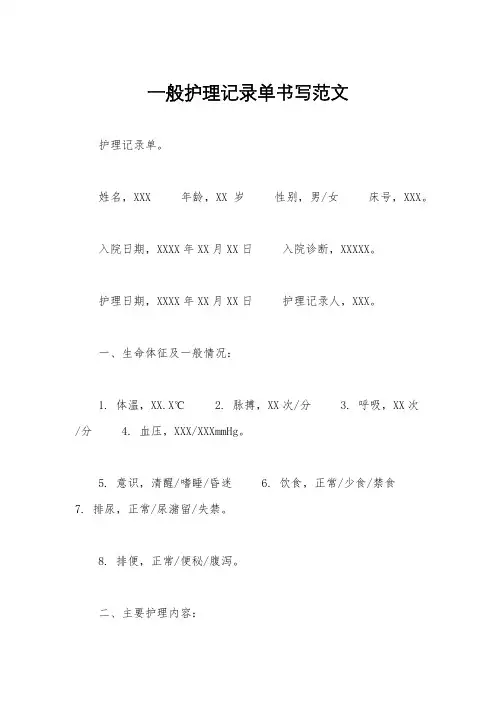
一般护理记录单书写范文护理记录单。
姓名,XXX 年龄,XX岁性别,男/女床号,XXX。
入院日期,XXXX年XX月XX日入院诊断,XXXXX。
护理日期,XXXX年XX月XX日护理记录人,XXX。
一、生命体征及一般情况:1. 体温,XX.X℃2. 脉搏,XX次/分3. 呼吸,XX次/分 4. 血压,XXX/XXXmmHg。
5. 意识,清醒/嗜睡/昏迷6. 饮食,正常/少食/禁食7. 排尿,正常/尿潴留/失禁。
8. 排便,正常/便秘/腹泻。
二、主要护理内容:1. 皮肤护理,清洁皮肤,保持干燥,定时翻身,预防压疮。
2. 导尿护理,定时更换尿袋,观察尿量和尿色,保持导尿通畅。
3. 饮食护理,根据医嘱给予适量饮食,观察饮食情况及进食量。
4. 睡眠护理,保持环境安静,营造舒适的睡眠环境,观察睡眠情况。
5. 洗浴护理,定时给予患者洗澡,保持个人卫生。
6. 康复训练,根据康复医师指导,进行康复训练,帮助患者康复。
7. 安全护理,保持环境整洁,防止跌倒和意外伤害。
8. 心理护理,与患者进行交流,关心患者的情绪变化,给予心理安慰。
三、特殊护理及注意事项:1. 给予特殊治疗,如雾化吸入、输液、换药等特殊治疗,观察治疗效果。
2. 观察病情变化,观察患者病情变化,及时报告医生。
3. 用药观察,观察患者用药情况及药物不良反应。
4. 定期复查,协助医生进行定期复查,如血常规、生化等检查。
四、护理记录:XXXX年XX月XX日。
患者生命体征平稳,无发热、心率正常,血压稳定。
患者精神状态良好,饮食进食情况良好,排尿排便正常。
皮肤无异常,导尿通畅,无不适感。
定时更换尿袋,观察尿量和尿色,保持导尿通畅。
睡眠良好,无不适感。
定时给予患者洗澡,保持个人卫生。
协助患者进行康复训练,患者情绪稳定,与患者交流良好,给予心理安慰。
患者安全意识良好,无意外伤害。
XXXX年XX月XX日。
患者生命体征平稳,无发热、心率正常,血压稳定。
患者精神状态良好,饮食进食情况良好,排尿排便正常。
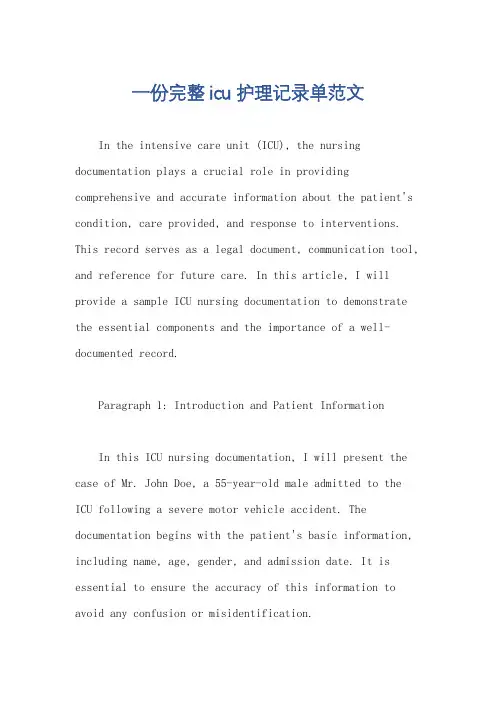
一份完整icu护理记录单范文In the intensive care unit (ICU), the nursing documentation plays a crucial role in providing comprehensive and accurate information about the patient's condition, care provided, and response to interventions. This record serves as a legal document, communication tool, and reference for future care. In this article, I will provide a sample ICU nursing documentation to demonstrate the essential components and the importance of a well-documented record.Paragraph 1: Introduction and Patient InformationIn this ICU nursing documentation, I will present the case of Mr. John Doe, a 55-year-old male admitted to the ICU following a severe motor vehicle accident. The documentation begins with the patient's basic information, including name, age, gender, and admission date. It is essential to ensure the accuracy of this information to avoid any confusion or misidentification.Paragraph 2: Presenting Complaint and Medical HistoryMr. Doe was admitted to the ICU with complaints of severe chest pain, shortness of breath, and multiple fractures. His medical history includes hypertension, diabetes mellitus, and a previous myocardial infarction. It is crucial to incorporate the patient's presenting complaints and medical history to provide a comprehensive understanding of the patient's condition and potential risk factors.Paragraph 3: Assessment Findings and Vital SignsUpon admission, Mr. Doe's assessment findings revealed a conscious but anxious patient with labored breathing. His vital signs were as follows: heart rate 110 beats per minute, blood pressure 150/90 mmHg, respiratory rate 28 breaths per minute, oxygen saturation 90% on room air. These assessment findings and vital signs indicate the severity of the patient's condition and the need for immediate intervention.Paragraph 4: Nursing Interventions and ResponseNursing interventions implemented for Mr. Doe included administering supplemental oxygen via a nasal cannula, initiating cardiac monitoring, and providing pain management. The patient's response to these interventions was monitored closely. Within 30 minutes, the patient's oxygen saturation improved to 95% on a 2-liter nasal cannula, and his pain score decreased from 8/10 to 4/10. These positive responses demonstrate the effectiveness of the nursing interventions provided.Paragraph 5: Medications and Laboratory ResultsDuring Mr. Doe's ICU stay, various medications were administered, including intravenous morphine for pain control, sublingual nitroglycerin for chest pain, and insulin for glycemic control. Laboratory results showed an elevated troponin level, indicating myocardial injury. These medication administrations and laboratory results are vital to document as they guide further treatment decisionsand provide a comprehensive picture of the patient's condition.Paragraph 6: Collaborative Care and Discharge PlanningThroughout Mr. Doe's ICU stay, a multidisciplinary approach was adopted to ensure comprehensive care. This involved regular communication and collaboration with the medical team, respiratory therapists, physical therapists, and social workers. Discharge planning was initiated earlyto ensure a smooth transition to a lower level of care. The patient's family was also involved in the decision-making process, providing emotional support and educationregarding post-discharge care.In conclusion, a well-documented ICU nursing record is essential for providing comprehensive and accurate information about the patient's condition, care provided, and response to interventions. It serves as a legal document, communication tool, and reference for future care. By incorporating the patient's information, medical history, assessment findings, interventions, medicationadministration, and collaborative care, a complete ICU nursing documentation can be achieved, ensuring high-quality patient care and continuity of care.。

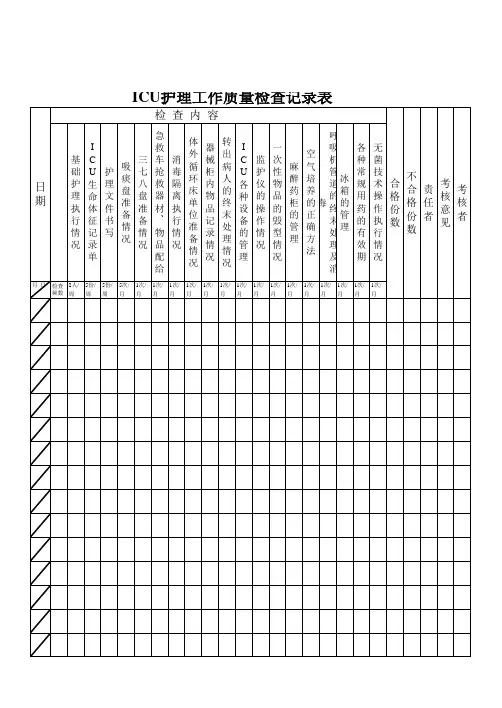
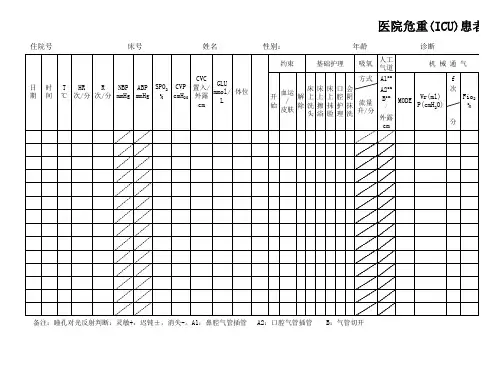

(五)ICU护理记录单填写说明(见表2)ICU护理记录单适用于ICU的重症患者。
记录频次:每小时记录一次,病情变化随时记录,根据ICU监护记录表格内容据实填写。
1、体温:单位为℃,直接在“体温”栏内填入测得数值。
体温Q4h记录(2-6-10-14-18-22)。
2、脉搏、呼吸:单位为次/分,直接在“脉搏”或“呼吸”栏内填入测得数值。
Q1h记录。
3、血压:单位为mmHg。
直接在“NIBP”或“IBP”栏内填入测得数值。
Q1h记录。
4、血氧饱和度:直接在“SPO2”栏内填入测得数值根据实际填写数值。
Q1h记录。
5、CVP:单位为mmHg,直接在“CVP”栏内填入测得数值。
6、血糖:单位为mmol/L,直接在“血糖”栏填入数值。
7、心律:填入病人心律类型。
每班接班时记录一次。
8、意识:A清醒、B嗜睡、C意识模糊、D昏睡、E浅昏迷、F 深昏迷、G谵妄状态、H镇静。
Q1h记录。
9、瞳孔大小及对光反射:大小单位mm,直接填入数值。
瞳孔:A灵敏、B迟钝、C消失、D眼疾,填入对应字母。
Q1h记录。
10、出入量:①入量:单位为ml,“名称”栏填写入量的名称,“输入”栏填写量,“饮入”栏填写饮入量,按执行医嘱时间填写。
②出量:单位为ml,包括:尿量、大便、痰液、其它量:呕吐量、各种引流量等并记录颜色、性质。
11、吸氧:单位为L/min,吸氧方式:A鼻塞、B鼻导管、C面罩、D其他等。
Q1h记录。
12、管路护理:根据患者置管情况填写:A尿管、B伤口引流管、C胸腔闭式引流管、D胃管、E膀胱造瘘管、F.CVC管、G.PICC管、H脑室引流管、I其它。
13、气管切开患者在“切开”栏内打“√”。
每班接班时记录一次。
14、导管长度:单位cm,气管插管:记录气管插管尖端距门齿的长度,胃管,鼻肠管:记录插入的长度。
根据实际情况在相应栏内填入数值。
每班接班时记录一次。
15、呼吸机模式及参数:模式:直接在“模式”栏内填入呼吸机的实际使用模式。
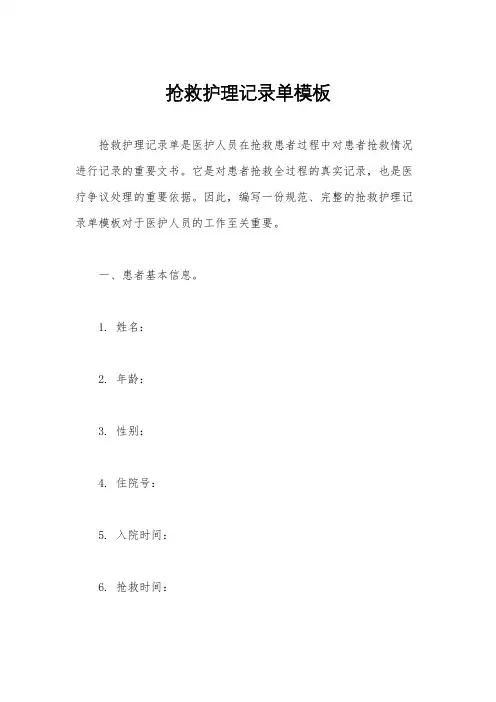
抢救护理记录单模板抢救护理记录单是医护人员在抢救患者过程中对患者抢救情况进行记录的重要文书。
它是对患者抢救全过程的真实记录,也是医疗争议处理的重要依据。
因此,编写一份规范、完整的抢救护理记录单模板对于医护人员的工作至关重要。
一、患者基本信息。
1. 姓名:2. 年龄:3. 性别:4. 住院号:5. 入院时间:6. 抢救时间:二、抢救前情况。
1. 主要症状:2. 抢救前生命体征:(1)血压:(2)心率:(3)呼吸:(4)体温:3. 抢救前意识状态:4. 抢救前处理情况:三、抢救过程。
1. 抢救开始时间:2. 抢救人员及分工:3. 使用的抢救设备:4. 抢救过程中的处理措施:(1)心肺复苏:(2)气管插管:(3)药物使用:(4)其他特殊操作:5. 抢救过程中监测的生命体征:(1)血压变化:(2)心率变化:(3)呼吸情况:(4)其他监测指标:四、抢救后情况。
1. 抢救后生命体征:(1)血压:(2)心率:(3)呼吸:(4)体温:2. 意识状态:3. 抢救后处理情况:4. 抢救后医嘱:5. 抢救后转归及预后评估:五、抢救结束时间及护理记录员签名。
1. 抢救结束时间:2. 护理记录员签名:以上是一份抢救护理记录单的模板,医护人员在填写抢救护理记录单时,应当认真、细致地记录患者的抢救过程和抢救后情况,确保信息的完整和准确。
同时,抢救护理记录单应当及时归档存储,以备日后查阅和参考。
希望医护人员能够严格按照抢救护理记录单模板的要求进行记录,提高抢救工作的规范性和专业性,确保患者的生命安全和抢救工作的顺利进行。
护理记录单模板CSICU护理记录单模板手术后转入患者:患者术毕返ICU,呼吸机辅助呼吸,遵医嘱给予重症监护、禁食水,抗生素等药物应用。
左/右挠动脉/肘动脉/股动脉测压管通畅,左/右手背/前臂套管针通畅,各穿刺处皮肤均无红肿外渗。
胸腔引流管通畅,引流液呈血性。
留置尿管通畅,尿液清晰(浑浊)呈淡黄色/深黄色/酱油色//肉眼血尿,四肢采取保护性约束措施,保暖。
查血气生化。
手术后:调呼吸机。
给予0.5%碘伏消毒尿道口。
扣背,鼓励咳嗽患者夜间断睡眠约6小时,晨起诉无不适,协助洗漱,进早餐。
拔气管插管:遵医嘱给予充分吸痰后拔除气管插管,持续氧气吸入、雾化吸入。
转出患者:遵医嘱拔除左/右挠动脉/肘动脉/股动脉测压管、左/右手背/前臂套管针,局部无异常,拔除尿管。
患者于1月1日在全麻下行术,现术后第2天,神志清、精神差,食欲(正常、差、好),大小便正常,现遵医嘱转往心外科。
新入患者:患者以为诊断,于1月1日16时急诊/平诊入院,步入/轮椅推入/平车推入ICU病房/由家属抱入ICU病房。
神志清、精神差,食欲正常,大小便均正常。
由院外带入套管针通畅,穿刺处皮肤无红肿外渗。
遵医嘱给予重症监护,饮食,抗菌、化痰、血管活性药物及保护胃黏膜等药物应用。
出院患者:患者于日入院,入院后完善相关检查,于日在全麻下行、术,卫毕返ICU,医嘱给予重症监护抗菌、化痰、血管活性药物及保护胃黏膜等药物应用。
现患者术后第天,神志清,精神差,遵医嘱于今日出院,于时离幵监护室。
自动放弃出院:患者于1月1旦入院,入院后完善相关检查,于1月2日在全麻下行术,术毕返ICU,医嘱给予重症监护抗菌、化痰、血管活性药物及保护胃黏膜等药物应用。
现患者术后第10天,神志昏迷/模糊/清,告病危,医生告知家属病情危重,家属要求出院/转院治疗,遵医嘱给予出院,于16时离幵监护室。
死亡小结:患者于1月1日入院,入院后完善相关检查,于1月2日在全麻下行术,术毕返ICU,医嘱给予重症监护抗菌、化痰、血管活性药物及保护胃黏膜等药物应用。
危重护理记录单范文危重护理记录单。
姓名,XXX 年龄,XX岁性别,男床号,XXX。
入院日期,XXXX年XX月XX日时间,XX:XX。
入院诊断,XXX。
主治医生,XXX 责任护士,XXX。
一、病情观察。
1. 患者神志清楚,表情痛苦,呼吸急促,气促加重,呼吸频率XX次/分,呼吸幅度增大,呼吸困难,出现端坐呼吸姿势。
2. 患者面色苍白,皮肤湿冷,四肢发绀,心率XX次/分,血压XX/XXmmHg,出现低血压症状。
3. 患者出现心率不齐,心音遥远,心音减弱,心音分裂,心音增强,心音减弱,心音消失等心音异常。
4. 患者出现心律失常,心律不齐,心律过速,心律过缓等心律异常。
5. 患者出现心肌梗死,心肌缺血,心肌损伤,心肌炎等心肌病变。
6. 患者出现肺部感染,肺部充血,肺部水肿,肺部出血等肺部病变。
7. 患者出现肾功能不全,肾功能衰竭,肾功能减退,肾功能异常等肾功能异常。
8. 患者出现肝功能不全,肝功能衰竭,肝功能减退,肝功能异常等肝功能异常。
9. 患者出现DIC,DIC综合征,DIC症候群等DIC症状。
10. 患者出现MODS,多器官功能衰竭,多器官损伤,多器官功能障碍等多器官功能障碍。
11. 患者出现休克,休克状态,休克反应等休克症状。
12. 患者出现电解质紊乱,酸碱平衡失调,水电解质紊乱等电解质紊乱症状。
13. 患者出现代谢性酸中毒,代谢性碱中毒,代谢性紊乱等代谢性疾病。
14. 患者出现感染性休克,感染性休克,感染性休克等感染性疾病。
15. 患者出现心肌梗死,心肌缺血,心肌损伤,心肌炎等心肌病变。
16. 患者出现脑供血不足,脑血管痉挛,脑血管意外等脑血管疾病。
17. 患者出现脑水肿,脑出血,脑栓塞等脑部疾病。
18. 患者出现脑功能障碍,脑损伤,脑缺血,脑缺氧等脑功能异常。
19. 患者出现颅内感染,颅内出血,颅内压增高等颅内疾病。
20. 患者出现颅内压增高,颅内感染,颅内出血等颅内疾病。
21. 患者出现颅内感染,颅内出血,颅内压增高等颅内疾病。
icu护理记录单书写模板
ICU(重症监护室)护理记录单是用来记录ICU患者在监护期间
的各项护理情况和医疗信息的重要文件,以便医护人员随时了解患
者的病情和护理情况。
护理记录单的书写模板通常包括以下内容:
1. 患者基本信息,包括患者姓名、年龄、性别、入院日期、住
院号等基本信息。
2. 生命体征监测,记录患者的体温、脉搏、呼吸、血压等生命
体征的监测情况,通常以图表或表格形式呈现,以便于医护人员快
速了解患者的生命体征变化趋势。
3. 治疗措施,记录患者接受的各项治疗措施,包括药物治疗、
手术、特殊护理等内容,以及治疗的时间、剂量和效果等信息。
4. 护理观察,记录护理人员对患者的观察情况,包括意识状态、皮肤情况、排泄情况、饮食摄入情况等内容,以及护理人员的护理
措施和效果评估。
5. 实验室检查,记录患者接受的各项实验室检查项目和结果,
包括血常规、生化指标、微生物培养等内容,以及医嘱的执行情况
和结果分析。
6. 医嘱执行情况,记录医生的医嘱内容和护理人员的执行情况,包括用药情况、特殊护理要求、饮食要求等内容,以及护理人员的
反馈和问题汇报。
7. 其他信息,根据患者的具体情况,还可以包括特殊事件记录、家属沟通内容、医患沟通内容等其他重要信息。
在书写ICU护理记录单时,护理人员应该准确、清晰地记录相
关信息,确保记录的完整性和可读性,以便医护人员随时了解患者
的病情和护理情况,为患者提供及时有效的医疗护理服务。
术后危重护理记录单的范文一、患者基本信息。
姓名:李大爷。
性别:男。
年龄:65岁。
手术名称:心脏搭桥手术。
手术日期:[具体日期]入重症监护室(ICU)日期:[手术当天日期]二、记录时段。
[开始日期] [结束日期]三、护理记录。
# (一)术后当天。
1. 13:00 14:00.李大爷刚从手术室推回来,那脸色白得像纸一样。
身上插着好多管子,看着怪吓人的。
心率110次/分,血压有点低,才90/60 mmHg,就像一个摇摇欲坠的小树苗。
我赶紧调整了一下他的输液速度,把床头稍微抬高了一点,希望他能舒服点。
他还在昏迷当中,眼睛紧紧闭着,真希望他能快点醒过来呀。
2. 14:00 15:00.体温量出来是35.5℃,有点低。
我给他加盖了一层薄被子,就像给小宝宝盖被子一样小心翼翼的。
这个时候他的心率稍微降了一点,到100次/分了,血压也稳住了一些,95/65 mmHg,这让我心里稍微踏实了一点。
不过他的伤口还在渗血,虽然不多,但也得密切盯着,我每隔10分钟就去看一下伤口的情况。
3. 15:00 16:00.李大爷的手指头动了一下,这可把我高兴坏了,就像看到了黑暗中的一丝曙光。
我轻声在他耳边说:“李大爷,您能听到我说话吗?”但是他没有其他反应。
我又检查了一下各种仪器设备,都还正常运转着,就像一群忠诚的小卫士守护着他。
# (二)术后第一天。
1. 08:00 09:00.早上来接班的时候,李大爷的情况比昨天稍微好了一点。
他已经睁开眼睛了,但是眼神很迷茫,估计还没完全清醒。
我笑着对他说:“李大爷,您可算醒了,可把我们担心坏了。
”他张了张嘴,但是没说出话来。
心率在90次/分左右,血压100/70 mmHg,体温也回升到了36.2℃,这都是好兆头啊。
我给他用棉球蘸了点水,润了润嘴唇,他的嘴唇干得都起皮了。
2. 09:00 10:00.医生来查房了,检查了李大爷的伤口,说渗血的情况有所改善,这可真是个天大的好消息。
不过医生也叮嘱我们还是要小心护理,毕竟这是心脏手术,可不能掉以轻心。
备注:
神志:1.清醒;2.嗜睡;3.意识模糊;4.昏睡;5.浅昏迷;6.深昏迷。
瞳孔反射:1.灵敏;2.迟钝;3.无。
人工气道方式:1.经口播管;2.气管切开;3.鼻插管;4.面罩。
吸氧方式:1.鼻塞;2.鼻导管;3.面罩;4.气管插管;5.气切导管。
呼吸音:用√表示清晰1.上低;2.下低;3.上痰鸣音;4.下痰鸣音;5其他。
静脉导管:1.外周;2.中心静脉(a颈内b锁骨下c股静脉);3.PlCC
管道:1、尿管;2.普通胃管;3.鼻肠管;4.T管;5.切口引流管;6.胸引管;7.腹腔引流管;8.其他通畅用√.
引流液颜色:1.血性;2.褐色;3.黄色;4.其他。
痰色:1.白粘痰;2.黄脓痰;3.稀薄粘痰;4.血性痰;5.粘痰略带血性。
痰量:1.少量;2.中等;3.大量。
约束末梢循环:1.良好;2.水肿;3.青紫:4.其他。
其他护理项目:1.洗头;2.换床单;3.换尿垫;4.换衣裤;5.协助进食水;6.面部清洁和梳头;7.足部清洁;8.趾/指甲护理。
约束部位:1.上肢;2.下肢;3.上下肢;4.胸部。
皮肤:用√完好,有问题请在病情中具体描述皮肤护理:1.气垫床;2.翻身q2h;3.局部皮肤换药(压疮评估见评估表)。